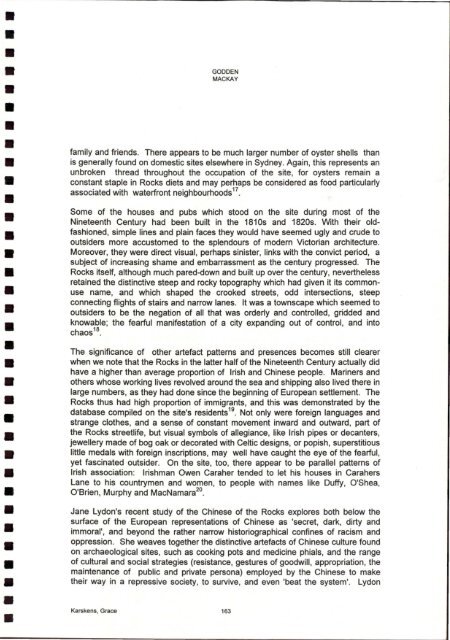Private Pleasures
Private Pleasures
Private Pleasures
You also want an ePaper? Increase the reach of your titles
YUMPU automatically turns print PDFs into web optimized ePapers that Google loves.
GODDEN<br />
MACKAY<br />
family and friends. There appears to be much larger number of oyster shells than<br />
is generally found on domestic sites elsewhere in Sydney. Again, this represents an<br />
unbroken thread throughout the occupation of the site, for oysters remain a<br />
constant staple in Rocks diets and may perhaps be considered as food particularly<br />
associated with waterfront neighbourhoods 17 .<br />
Some of the houses and pubs which stood on the site during most of the<br />
Nineteenth Century had been built in the 1810s and 1820s. With their oldfashioned,<br />
simple lines and plain faces they would have seemed ugly and crude to<br />
outsiders more accustomed to the splendours of modern Victorian architecture.<br />
Moreover, they were direct visual, perhaps sinister, links with the convict period, a<br />
subject of increasing shame and embarrassment as the century progressed. The<br />
Rocks itself, although much pared-down and built up over the century, nevertheless<br />
retained the distinctive steep and rocky topography which had given it its commonuse<br />
name, and which shaped the crooked streets, odd intersections, steep<br />
connecting flights of stairs and narrow lanes. It was a townscape which seemed to<br />
outsiders to be the negation of all that was orderly and controlled, gridded and<br />
knowable; the fearful manifestation of a city expanding out of control, and into<br />
chaos 18 .<br />
The significance of other artefact patterns and presences becomes still clearer<br />
when we note that the Rocks in the latter half of the Nineteenth Century actually did<br />
have a higher than average proportion of Irish and Chinese people. Mariners and<br />
others whose working lives revolved around the sea and shipping also lived there in<br />
large numbers, as they had done since the beginning of European settlement. The<br />
Rocks thus had high proportion of immigrants, and this was demonstrated by the<br />
database compiled on the site's residents 19 . Not only were foreign languages and<br />
strange clothes, and a sense of constant movement inward and outward, part of<br />
the Rocks streetlife, but visual symbols of allegiance, like Irish pipes or decanters,<br />
jewellery made of bog oak or decorated with Celtic designs, or popish, superstitious<br />
little medals with foreign inscriptions, may well have caught the eye of the fearful,<br />
yet fascinated outsider. On the site, too, there appear to be parallel patterns of<br />
Irish association: Irishman Owen Caraher tended to let his houses in Carahers<br />
Lane to his countrymen and women, to people with names like Duffy, O'Shea,<br />
O'Brien, Murphy and MacNamara 20 .<br />
Jane Lydon's recent study of the Chinese of the Rocks explores both below the<br />
surface of the European representations of Chinese as 'secret, dark, dirty and<br />
immoral', and beyond the rather narrow historiographical confines of racism and<br />
oppression. She weaves together the distinctive artefacts of Chinese culture found<br />
on archaeological sites, such as cooking pots and medicine phials, and the range<br />
of cultural and social strategies (resistance, gestures of goodwill, appropriation, the<br />
maintenance of public and private persona) employed by the Chinese to make<br />
their way in a repressive society, to survive, and even 'beat the system'. Lydon ·<br />
Karskens, Grace 163




